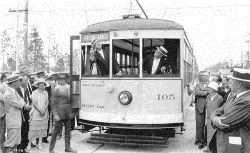A Special Moment In Time: The Time of The Trolley: Part III – Miami Beach
[AdSense-A]
For the past two issues this column has given brief histories of the Miami and Coral Gables streetcar systems. This week, the focus turns to Miami Beach, where, indeed, from December 8, 1920 until October 17, 1939, trolleys operated to and from Miami and on several lines on Miami Beach.
Edward Ridolph’s wonderful book, Biscayne Bay Trolleys (published in 1981) presents most of the story of the trolley car era in Greater Miami and it seems that the Miami Beach operation was the most fascinating of the three systems, particularly because it crossed the County (now MacArthur) Causeway to reach the just over three year old city when service was first inaugurated. (Miami Beach was incorporated as a town on March 26, 1915 and then, in 1917, became a city, the third incorporated municipality in Dade County following Miami in 1896 and Homestead in 1913).
As with almost everything else early Miami Beach, Carl Fisher had his hand in the trolley’s premiere on the island city. However, before he got involved with the street car operation he built some kind of short tram railroad that ran on a boardwalk on the beach and served one or more of the casinos. While there are several pictures of the track directly on the beach there are no known images of the passenger cars themselves. Fisher, promoter that he was, sent passes on the little line to railroad presidents throughout the country for use on his “Miami Beach Railway” and several even responded with complimentary passes for his and his wife Jane’s use.
But the first “real” street car ran to and from the trolley barn (Ridolph says it was more like a shed!) on December 8, 1920, that building having been erected at the east end of the causeway, just east of where the Fisher Island ferry loads for its trips across Government Cut. The Miami to Miami Beach line was a success from its first day and the initial ten cent fare remained the same for the entire life of the line.
Because of developments north of Dade Boulevard Miami Beach Railway Company determined the timing was right to build two lines on Miami Beach, one of them going up Alton Road, crossing Dade Boulevard, and proceeding north to 45th Street in order to serve Fisher’s Nautilus Hotel as well as his polo fields. (Polo Park, the site of Nautilus Middle School, and the homes on Nautilus Drive and North Michigan Avenue are on the site of the polo fields).
The other line ran up Washington Avenue to Dade Boulevard, swung east the two blocks to Pinetree Drive and ran up Pinetree all the way to the other side of the 51st Street bridge. While the Alton Road line proved somewhat of a success, the Pinetree Drive line was a complete bust, having been built well in advance of any northerly development on Miami Beach.
In 1925 the railway company completed a loop around south beach using Alton Road, Biscayne Street, Fifth Street and Washington Avenue and over the years the loop was used for different routings of the cars. The lines south of Dade Boulevard were so well used that even the horrific 1926 hurricane did not end service, and, in fact, it would only be the corrupt and paid off by the oil and gas companies, road builders, auto manufacturers and tire and rubber companies as well as the corrupt mayor of the city of Miami, Everest (Ev) Sewell, who had accepted bribes to demean the trolley cars as noisy, slow and old fashioned—none of which was true–that the bustitution of the quiet, pollution free, environmentally friendly and ecologically advantageous electrically powered trolleys occurred. It was Sewell’s absolute and utter lies which led to the destruction of a system that, had the right things been done, would be in operation today.
Think about it, dear readers: you cannot even begin to imagine the tremendous tourist attraction that we would never have lost had the streetcars crossing the causeway continued to operate from downtown Miami to Miami Beach. Indeed, the damn fools killed what would have been the absolute equal to San Francisco’s fabled cable cars as national icons and historic landmarks had they only left well enough alone and left Miami and Miami Beach’s streetcars in place. Sadly, the same level of avariciousness, greed, stupidity and corruption, as evinced and evidenced in Miami Beach’s, Miami’s, the County’s and many of our local municipal governments is still in hand and at play and, indeed, more is the pity.
Next issue, then, a look at the incredibly inept and totally mismanaged operation(s) of MetroFAIL and TriFAIL and how they both have lost—if they had any to start with—all public credibility. See you then.
[si-contact-form form=’2′]


